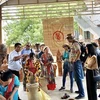 A house on stilts located in Bat Trang in Hanoi’s Gia Lam district is a must-see on any visit to the ancient traditional craft village. The village is well known for its traditional pottery trade. It was said that the people of Bo Bat village (now Yen Thanh commune in the northern province of Ninh Binh) followed King Ly Cong Uan when he moved the capital city from Hoa Lu, in Ninh Binh, to Thang Long, now Hanoi, in 1010. They then set up a pottery and brick-making ward on the left bank of the Red River, which is now Bat Trang. (Photo: VietnamPlus)
A house on stilts located in Bat Trang in Hanoi’s Gia Lam district is a must-see on any visit to the ancient traditional craft village. The village is well known for its traditional pottery trade. It was said that the people of Bo Bat village (now Yen Thanh commune in the northern province of Ninh Binh) followed King Ly Cong Uan when he moved the capital city from Hoa Lu, in Ninh Binh, to Thang Long, now Hanoi, in 1010. They then set up a pottery and brick-making ward on the left bank of the Red River, which is now Bat Trang. (Photo: VietnamPlus)  The house on stilts is an ancient space preserving many antiques dating back to the 16th century. Lying on the left bank of the Hong (Red) River, the Bat Trang ancient village is not only a place to preserve the traditional culture of Hanoi, but also one of the largest suppliers of ceramics in the country. After many ups and downs during its long history, the Bat Trang pottery village today is an attractive destination to tourists, as well as people nearby, particularly on weekends. Visitors can learn about the ceramic industry, buy excellent ceramic products, and make pottery products themselves. (Photo: VietnamPlus)
The house on stilts is an ancient space preserving many antiques dating back to the 16th century. Lying on the left bank of the Hong (Red) River, the Bat Trang ancient village is not only a place to preserve the traditional culture of Hanoi, but also one of the largest suppliers of ceramics in the country. After many ups and downs during its long history, the Bat Trang pottery village today is an attractive destination to tourists, as well as people nearby, particularly on weekends. Visitors can learn about the ceramic industry, buy excellent ceramic products, and make pottery products themselves. (Photo: VietnamPlus)  Antiques on display in the stilt house are mainly ceramic items of the Bat Trang pottery village. They are collected and preserved by the house’s owner. Located in the outlying district of Gia Lam, Hanoi, Bat Trang is the only commune in the northern delta region not associated with agriculture. Bat Trang village is famous throughout the country not only for its ceramic-making craft but also for its time-honoured culture, century-old clans and spiritual traditions. In Bat Trang, the relics of communal houses, temples, pagodas and literature documents are still preserved. It is a special village as it is home to five types of sacred architecture. (Photo: VietnamPlus)
Antiques on display in the stilt house are mainly ceramic items of the Bat Trang pottery village. They are collected and preserved by the house’s owner. Located in the outlying district of Gia Lam, Hanoi, Bat Trang is the only commune in the northern delta region not associated with agriculture. Bat Trang village is famous throughout the country not only for its ceramic-making craft but also for its time-honoured culture, century-old clans and spiritual traditions. In Bat Trang, the relics of communal houses, temples, pagodas and literature documents are still preserved. It is a special village as it is home to five types of sacred architecture. (Photo: VietnamPlus)  Each item on display is associated with a development period of the culture and history of the Bat Trang craft village. It was said that the people of Bo Bat village (now Yen Thanh commune, the northern province of Ninh Binh) followed King Ly Cong Uan when he moved the capital city from Hoa Lu in Ninh Binh to Thang Long, now Hanoi, in 1010. They set up a pottery and brick-making ward on the left bank of the Red River, which is now Bat Trang. After hundreds of years, the traditional ceramic village has affirmed its position and brand name in domestic and foreign markets. (Photo: VietnamPlus)
Each item on display is associated with a development period of the culture and history of the Bat Trang craft village. It was said that the people of Bo Bat village (now Yen Thanh commune, the northern province of Ninh Binh) followed King Ly Cong Uan when he moved the capital city from Hoa Lu in Ninh Binh to Thang Long, now Hanoi, in 1010. They set up a pottery and brick-making ward on the left bank of the Red River, which is now Bat Trang. After hundreds of years, the traditional ceramic village has affirmed its position and brand name in domestic and foreign markets. (Photo: VietnamPlus)  The stilt house is a favourite destination for tourists to learn about ancient Vietnamese culture. In addition to the bustling pottery market, there are houses with old tile roofs in Bat Trang, including some hundreds of years old and others that have been restored with the ancient architecture of the northern delta. It is a special village as it is home to five types of sacred architecture. The sacred architecture types are Dinh (a communal house worshipping a village’s tutelary gods), Den (a temple dedicated to gods or revered national heroes), Chua (a Buddhist pagoda), Van Chi (a temple dedicated to Confucius) and Mieu (a shrine dedicated to nature or supernatural figures). (Photo: VietnamPlus)
The stilt house is a favourite destination for tourists to learn about ancient Vietnamese culture. In addition to the bustling pottery market, there are houses with old tile roofs in Bat Trang, including some hundreds of years old and others that have been restored with the ancient architecture of the northern delta. It is a special village as it is home to five types of sacred architecture. The sacred architecture types are Dinh (a communal house worshipping a village’s tutelary gods), Den (a temple dedicated to gods or revered national heroes), Chua (a Buddhist pagoda), Van Chi (a temple dedicated to Confucius) and Mieu (a shrine dedicated to nature or supernatural figures). (Photo: VietnamPlus)  In the house, there is an alter worshipping Vietnamese writer Kim Lan, best known for his short stories about country life in northern Vietnam. The writer was born in 1920 to a farming family in Tu Son district, Bac Ninh province. After primary school, he became a lacquer painter. He started his writing career when he published his first novel Dua Con Nguoi Vo Le (Son of a Concubine) in 1941 in Hanoi. Later, he wrote a series of short stories, mostly related to his recollections of country life. He vividly narrated Vietnam’s countryside traditions and villagers’ complicated attitudes regarding social and familial relationships. (Photo: VietnamPlus)
In the house, there is an alter worshipping Vietnamese writer Kim Lan, best known for his short stories about country life in northern Vietnam. The writer was born in 1920 to a farming family in Tu Son district, Bac Ninh province. After primary school, he became a lacquer painter. He started his writing career when he published his first novel Dua Con Nguoi Vo Le (Son of a Concubine) in 1941 in Hanoi. Later, he wrote a series of short stories, mostly related to his recollections of country life. He vividly narrated Vietnam’s countryside traditions and villagers’ complicated attitudes regarding social and familial relationships. (Photo: VietnamPlus)  It is said that the stilt house is owned by one of writer Kim Lan’s children. Writer Kim Lan (1020 – 2007) was also known for his performance in the film Lang Vu Dai Ngay Ay (Vu Dai Village) based on the work of Vietnamese realist author Nam Cao. In the film, he played the role of Lao Hac, a peasant struggling during the Vietnamese feudal and colonial period 1930-1945. He also acted in the film ‘Vo Chong A Phu’ (Couple of A Phu) based on the short story of the same name by writer To Hoai. He was presented the State Prize in 2001 for his contribution to the nation’s literature. (Photo: VietnamPlus)
It is said that the stilt house is owned by one of writer Kim Lan’s children. Writer Kim Lan (1020 – 2007) was also known for his performance in the film Lang Vu Dai Ngay Ay (Vu Dai Village) based on the work of Vietnamese realist author Nam Cao. In the film, he played the role of Lao Hac, a peasant struggling during the Vietnamese feudal and colonial period 1930-1945. He also acted in the film ‘Vo Chong A Phu’ (Couple of A Phu) based on the short story of the same name by writer To Hoai. He was presented the State Prize in 2001 for his contribution to the nation’s literature. (Photo: VietnamPlus)  Before the COVID-19 pandemic, the stilt house welcomed many local and foreign tourists each day. The Bat Trang pottery village, 15km from Hanoi, is an ideal destination for weekend trips with many unique activities related to the tradition of making ceramic and porcelain products. Located in an area rich in clay, the Bat Trang village enjoys the advantages of ingredients to create fine ceramics. Bat Trang ceramics are produced for daily household use such as bowls, cups, plates, pots, and bottles as well as for worshipping or decoration purposes. Artists brought into ceramics many innovations in production techniques, and creativity in products’ features, giving birth to many new products, and even daily household items. (Photo: VietnamPlus)
Before the COVID-19 pandemic, the stilt house welcomed many local and foreign tourists each day. The Bat Trang pottery village, 15km from Hanoi, is an ideal destination for weekend trips with many unique activities related to the tradition of making ceramic and porcelain products. Located in an area rich in clay, the Bat Trang village enjoys the advantages of ingredients to create fine ceramics. Bat Trang ceramics are produced for daily household use such as bowls, cups, plates, pots, and bottles as well as for worshipping or decoration purposes. Artists brought into ceramics many innovations in production techniques, and creativity in products’ features, giving birth to many new products, and even daily household items. (Photo: VietnamPlus)  Each item is associated with a story. Bat Trang ceramic products are appreciated for their quality, design and categories, divided into functional groups such as household ceramics, worship items, fine pottery artworks, building ceramics and decorative ceramics. The items are spread out all over Vietnam and have been exported to many other countries. Lying on the left bank of the Red River, the Bat Trang pottery village is an ideal destination for weekend trips with many unique activities related to the tradition of making ceramic and porcelain products. The village is not only a place to make a national product brand, contributing to preserving the cultural values of the capital, but also one of the popular tourist destinations in Hanoi. (Photo: VietnamPlus)
Each item is associated with a story. Bat Trang ceramic products are appreciated for their quality, design and categories, divided into functional groups such as household ceramics, worship items, fine pottery artworks, building ceramics and decorative ceramics. The items are spread out all over Vietnam and have been exported to many other countries. Lying on the left bank of the Red River, the Bat Trang pottery village is an ideal destination for weekend trips with many unique activities related to the tradition of making ceramic and porcelain products. The village is not only a place to make a national product brand, contributing to preserving the cultural values of the capital, but also one of the popular tourist destinations in Hanoi. (Photo: VietnamPlus)  The living room is placed on the upper floor of the stilt house. Bat Trang is a special village as it is home to five types of sacred architecture. The sacred architecture types are Dinh (a communal house worshipping a village’s tutelary gods), Den (a temple dedicated to gods or revered national heroes), Chua (a Buddhist pagoda), Van Chi (a temple dedicated to Confucius) and Mieu (a shrine dedicated to nature or supernatural figures). Bat Trang’s Van Chi is located behind the village’s communal house. The Van Chi was set up as early as the establishment of the village to worship Confucius, his disciples and local people who had passed the exams held by the feudal regime. (Photo: VietnamPlus)
The living room is placed on the upper floor of the stilt house. Bat Trang is a special village as it is home to five types of sacred architecture. The sacred architecture types are Dinh (a communal house worshipping a village’s tutelary gods), Den (a temple dedicated to gods or revered national heroes), Chua (a Buddhist pagoda), Van Chi (a temple dedicated to Confucius) and Mieu (a shrine dedicated to nature or supernatural figures). Bat Trang’s Van Chi is located behind the village’s communal house. The Van Chi was set up as early as the establishment of the village to worship Confucius, his disciples and local people who had passed the exams held by the feudal regime. (Photo: VietnamPlus)  The stilt house is decorated with many ceramics. The village has a long history, which could date back to a thousand years ago. In 1010, King Ly Cong Uan moved the capital city from Hoa Lu (Ninh Binh) to Thang Long (now Hanoi). Attracted by the development demand of the new capital city, many traders and craft men from all corners of the country flocked to Thang Long. It was said that some craftsmen of the Bo Bat pottery-making village (now Yen Thanh commune, the northern province of Ninh Binh) also moved to Thang Long. They set up a pottery and brick-making ward on the banks of the Red River, which is now Bat Trang. (Photo: VietnamPlus)
The stilt house is decorated with many ceramics. The village has a long history, which could date back to a thousand years ago. In 1010, King Ly Cong Uan moved the capital city from Hoa Lu (Ninh Binh) to Thang Long (now Hanoi). Attracted by the development demand of the new capital city, many traders and craft men from all corners of the country flocked to Thang Long. It was said that some craftsmen of the Bo Bat pottery-making village (now Yen Thanh commune, the northern province of Ninh Binh) also moved to Thang Long. They set up a pottery and brick-making ward on the banks of the Red River, which is now Bat Trang. (Photo: VietnamPlus)  Bat Trang village is one of many ancient traditional craft villages in the country. The village is well known for its traditional pottery trade. It was said that the people of Bo Bat village (now Yen Thanh commune, the northern province of Ninh Binh) followed King Ly Cong Uan when he moved the capital city from Hoa Lu in Ninh Binh to Thang Long, now Hanoi, in 1010. They then set up a pottery and brick-making ward on the banks of the Red River, which is now Bat Trang. After hundreds of years, the traditional ceramic village in Gia Lam district, Hanoi, has affirmed its position and brand name in domestic and foreign markets. (Photo: VietnamPlus)
Bat Trang village is one of many ancient traditional craft villages in the country. The village is well known for its traditional pottery trade. It was said that the people of Bo Bat village (now Yen Thanh commune, the northern province of Ninh Binh) followed King Ly Cong Uan when he moved the capital city from Hoa Lu in Ninh Binh to Thang Long, now Hanoi, in 1010. They then set up a pottery and brick-making ward on the banks of the Red River, which is now Bat Trang. After hundreds of years, the traditional ceramic village in Gia Lam district, Hanoi, has affirmed its position and brand name in domestic and foreign markets. (Photo: VietnamPlus)  Bat Trang commune is located in Gia Lam district, 10km from the city centre. It comprises Bat Trang and Giang Cao villages. A century ago, the people of Bo Bat village (now Yen Thanh commune, Ninh Binh province) followed King Ly Cong Uan from Hoa Lu to Thang Long - the new capital city (now Hanoi). They set up a pottery and brick-making ward on the left bank of the Red River, which is now Bat Trang. Bat Trang is the only commune in the northern delta region not associated with agriculture. It’s well-known for the traditional pottery trade. In recent years, tourists have flocked to Bat Trang to find traditional artefacts and buy ceramic wares. People also come to make pottery and go sightseeing. (Photo: VietnamPlus)
Bat Trang commune is located in Gia Lam district, 10km from the city centre. It comprises Bat Trang and Giang Cao villages. A century ago, the people of Bo Bat village (now Yen Thanh commune, Ninh Binh province) followed King Ly Cong Uan from Hoa Lu to Thang Long - the new capital city (now Hanoi). They set up a pottery and brick-making ward on the left bank of the Red River, which is now Bat Trang. Bat Trang is the only commune in the northern delta region not associated with agriculture. It’s well-known for the traditional pottery trade. In recent years, tourists have flocked to Bat Trang to find traditional artefacts and buy ceramic wares. People also come to make pottery and go sightseeing. (Photo: VietnamPlus)  The Bat Trang pottery village is located on the left bank of the Red River in the outlying Gia Lam district, about 15 km from downtown Hanoi. This is the oldest and most famous pottery village in Vietnam, attracting the attention of many domestic and foreign tourists before the COVID-19 broke out. There are many places to visit in Bat Trang, including old houses like the one owned by artisan To Thanh Son, Tieu Dao Pagoda, Bo Bat old kiln, Kim Truc Pagoda, Giang Cao Temple and Mother Goddesses Temple. Apart from these relics, the core of the Bat Trang commune is 23 traditional houses, 16 family temples and many old kilns, all built with Bat Trang bricks. (Photo: VietnamPlus)
The Bat Trang pottery village is located on the left bank of the Red River in the outlying Gia Lam district, about 15 km from downtown Hanoi. This is the oldest and most famous pottery village in Vietnam, attracting the attention of many domestic and foreign tourists before the COVID-19 broke out. There are many places to visit in Bat Trang, including old houses like the one owned by artisan To Thanh Son, Tieu Dao Pagoda, Bo Bat old kiln, Kim Truc Pagoda, Giang Cao Temple and Mother Goddesses Temple. Apart from these relics, the core of the Bat Trang commune is 23 traditional houses, 16 family temples and many old kilns, all built with Bat Trang bricks. (Photo: VietnamPlus) VNA



















